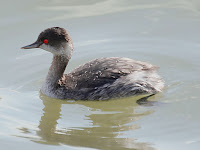EARED GREBE
EARED GREBE (Podiceps nigricollis) – (See images below)
DESCRIPTION: The Eared Grebe in breeding plumage has a black head, neck, throat and back. Breast and belly are white. There are cinnamon tuft feathers behind the eyes and extending down the neck. Sides are cinnamon. Eyes are red. Bill is short, pointed and black. Non-breeding plumage birds are mostly grey on top. Juveniles are brown-grey on top. Sexes are similar. Bird length is 30 cm (12 inches).
VOICE: https://www.xeno-canto.org/species/Podiceps-nigricollis
NAME: ‘Grebe’ might come from a Breton word that means ‘crest’. Latin genus name ‘Podiceps’ means ‘rump’ and ‘foot’, and refers to the placement of the birds’ feet near the rump. Latin species name ‘nigricollis’ means ‘black neck’. This species is called ‘Black-necked Grebe’ outside North America.
HABITAT: Prairie wetlands (ponds, lakes); also coastal bays in the winter.
DIET: Crustaceans, insects, small fish and amphibians.
NESTING: Floating platform attached to emergent vegetation. Usually three to five creamy eggs are laid, incubated by both parents, who also both feed the young.
DISTRIBUTION: Breeding range includes western half of USA, and central plains of Eurasia. Wintering grounds cover west coast of USA, Mexico, coasts of southern Europe, South Africa, and around Japan. Some individuals have been reported on Hawaii. (see note below on Bird Vagrancy).
Distribution Map: https://en.wikipedia.org/wiki/Black-necked_grebe#/media/File:Black-necked_Grebe-map-location-map-en.svg
ON PEI: Does not breed on Prince Edward Island, sightings accidental. The eared grebe does not breed on PEI and there’s only been an accidental sighting of this bird reported in the fall, and a hypothetical one (unconfirmed) in the winter.
CONSERVATION: Population stable, currently not at risk.
NOTES: Although this grebe can fly long distances during migration, its flight is considered as very ‘inefficient’, and it will avoid flying in other circumstances.
Vagrancy: In biology this means an animal going way outside its normal range. For birds, this can happen when there are storms and they get blown off course. On other times, the bird simply wanders in a different direction than usual. Here’s an article about vagrancy in birds.
SIMILAR SPECIES: Horned Grebe, Red-necked Grebe, Pied-billed Grebe
REFERENCES: https://en.wikipedia.org/wiki/Black-necked_grebe
https://www.audubon.org/field-guide/bird/eared-grebe
https://txtbba.tamu.edu/species-accounts/eared-grebe/ (Texas Breeding Bird Atlas)
https://birdatlas.mb.ca/accounts/speciesaccount.jsp?sp=EAGR&lang=en (Manitoba Breeding Bird Atlas)
https://www.allaboutbirds.org/guide/Eared_Grebe/lifehistory
DESCRIPTION: The Eared Grebe in breeding plumage has a black head, neck, throat and back. Breast and belly are white. There are cinnamon tuft feathers behind the eyes and extending down the neck. Sides are cinnamon. Eyes are red. Bill is short, pointed and black. Non-breeding plumage birds are mostly grey on top. Juveniles are brown-grey on top. Sexes are similar. Bird length is 30 cm (12 inches).
VOICE: https://www.xeno-canto.org/species/Podiceps-nigricollis
NAME: ‘Grebe’ might come from a Breton word that means ‘crest’. Latin genus name ‘Podiceps’ means ‘rump’ and ‘foot’, and refers to the placement of the birds’ feet near the rump. Latin species name ‘nigricollis’ means ‘black neck’. This species is called ‘Black-necked Grebe’ outside North America.
HABITAT: Prairie wetlands (ponds, lakes); also coastal bays in the winter.
DIET: Crustaceans, insects, small fish and amphibians.
NESTING: Floating platform attached to emergent vegetation. Usually three to five creamy eggs are laid, incubated by both parents, who also both feed the young.
DISTRIBUTION: Breeding range includes western half of USA, and central plains of Eurasia. Wintering grounds cover west coast of USA, Mexico, coasts of southern Europe, South Africa, and around Japan. Some individuals have been reported on Hawaii. (see note below on Bird Vagrancy).
Distribution Map: https://en.wikipedia.org/wiki/Black-necked_grebe#/media/File:Black-necked_Grebe-map-location-map-en.svg
ON PEI: Does not breed on Prince Edward Island, sightings accidental. The eared grebe does not breed on PEI and there’s only been an accidental sighting of this bird reported in the fall, and a hypothetical one (unconfirmed) in the winter.
CONSERVATION: Population stable, currently not at risk.
NOTES: Although this grebe can fly long distances during migration, its flight is considered as very ‘inefficient’, and it will avoid flying in other circumstances.
Vagrancy: In biology this means an animal going way outside its normal range. For birds, this can happen when there are storms and they get blown off course. On other times, the bird simply wanders in a different direction than usual. Here’s an article about vagrancy in birds.
SIMILAR SPECIES: Horned Grebe, Red-necked Grebe, Pied-billed Grebe
REFERENCES: https://en.wikipedia.org/wiki/Black-necked_grebe
https://www.audubon.org/field-guide/bird/eared-grebe
https://txtbba.tamu.edu/species-accounts/eared-grebe/ (Texas Breeding Bird Atlas)
https://birdatlas.mb.ca/accounts/speciesaccount.jsp?sp=EAGR&lang=en (Manitoba Breeding Bird Atlas)
https://www.allaboutbirds.org/guide/Eared_Grebe/lifehistory
 |
| Eared grebe, by Andreas Trepte |
 |
| Eared grebe, Japan, by Maga-chan |
 |
| Eared grebe adult with juvenile, by Sebastien Bertru |
 |
| Eared grebes courting, CA by Becky Matsubara |